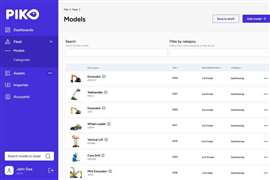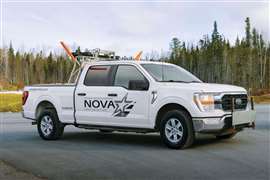Adding Value: The latest product drivers within the haulers sector
24 November 2009

Preparing for the next stage of engine emissions regulations remains the priority in hauler development. Enhancing machine productivity and fuel efficiency, while reducing operating costs is also a key focus. Becca Wilkins reports.
Manufacturers are immersed in developing the next wave of engine emission compliant haulers which will be launched in 2011. As well as featuring new engines, the models will be fitted with the latest systems and technologies that help improve operator comfort and safety, reduce fuel consumption as well as enhance fuel efficiency and overall machine productivity.
At the same time manufacturers are striving to lower operating costs - an important strategy in the current economic climate.
More for less
Head of engineering for Terex haulers, Alan Clark told iC meeting the Tier 4 deadline is going to be a challenge for all manufacturers.
He said, "In terms of engineering changes it's around integrating the technology efficiently into our machines and making sure that we continue to drive value for our customers. There are some challenges typically around emissions changes and Tier 4 is no different in terms of cooling performance and fuel efficiency."
He added contractors are looking to reduce the cost of owning a machine and so the company needs to find a way of using the Tier 4 change to drive value.
"Getting the maximum performance out of the product for the minimum cost is vital so if we're making technical changes for Tier 4 Interim is there some way we can use the technology to do that for our customers? That's a challenge that is on-going at the moment," Mr Clark explained.
Meanwhile, articulated dump truck (ADT), product manager for Komatsu America, Steve Moore said, "Compliance with all the emissions regulations is a main driver but we have to have the highest production in each machine class too because customers come to us and in this line of work the first thing they ask is how much does it carry? What's the production?"
Another driver is to be able to prove the machine has the lowest operating costs in terms of fuel and reliability, he added.
"Fuel has been in and out of the picture, it went up in price, now it's down - but fuel is still on everyone's mind. Contractors want to know how much it costs to operate the truck per hour. We built the truck, we designed it we know more than anybody so we're responsible for predicting our total operating costs and giving that to the customer," Mr Moore stated.
Elsewhere, worldwide strategy development manager, for Caterpillar's hauling systems, Chad Bixby said, "Contractors continue to feel the pressure to do more with less. As a result, we continue to look for opportunities to provide higher capacity in the equipment we bring to markets. At the same time, we focus on ways to improve production with a combination of equipment performance and capacity plus the on-site consultation provided from the local Cat dealer and Cat representatives to help them with proper hauler selection matched with the appropriate loading tool."
Fuelling technology
Hauler manufacturers are introducing and researching technologies that help reduce fuel consumption and improve fuel efficiency which, in turn, allows for more productive and environmentally friendly machines. Many of these technologies and systems are currently only available or being tested on rigid dump trucks (RDTs) used in mines, but manufacturers expect some of the systems to filter through to haulers used for construction applications.
Speaking for Hitachi, Malcolm Edwards said fuel efficiency and fuel consumption are important issues because of the price of diesel and with this in mind the company has introduced AC Drive technology - currently available on the EH3500ACII rigid hauler. This, he said allows the engine to be balanced against the electric drive system and therefore fuel going into the machine is optimised. However, Mr Edwards said it is not yet cost effective for the AC Drive technology to be installed on haulers weighing less than 175 tonnes.
For Komatsu, too, technological developments are rapidly advancing in its haulers used for mining. Product manager, for Komatsu America's mining trucks, Don Lindell, said the company's larger mining trucks are electrically driven, some are run autonomously and there is also potential to introduce a hybrid model.
However, Rob Warden, RDT product manager for Komatsu America said in future some of these technologies will transfer onto the company's construction haulers.
"We continually look at our technology and see how it can be improved or used on other models/product lines so we try not to develop a product specific technology because of how vast our product line is."
Mr Clark said with changes to the world economy in recent years the issue of fuel efficiency has become a key focus for the company.
"We are mindful of the need to consider fuel efficiency as part of the cost of ownership going forwards on all new truck development and we would like to think we will be able to deliver that on the new product that's coming out for Tier 4 Interim.
"Typically on our current Tier 3 trucks we derive fuel efficiency from the base engine performance. As we look forward to Tier 4 clearly the base engine is going to have a very big influence on fuel performance and fuel efficiency and the technology associated with the engine. However, we are definitely aware of opening up our thinking to other areas in the machine as well such as hydraulics and cooling systems - i.e. how the machine reacts in different parts of the haul cycle.
"We are looking at those elements of the machine again to understand how we can derive some reduction in fuel consumption without adversely affecting the fundamental performance and productivity of the machine," he added.
Meanwhile, Mr Moore said in the past few years Komatsu has addressed the issue of fuel consumption in haulers used for construction.
"We are one of the first companies to put in a power economy switch in our wheeled loaders, our trucks and excavators so if you don't need the power you can run in a lower mode," he added.
Using common rail injection on the engines and making a more efficient hydraulic system are some of the other improvements Komatsu has made he added.
He said, "The biggest thing from our standpoint is that we have the technology in-house, we develop our own engines and develop our own powertrains so we can set up our own powertrain matches. We're basically developing our trucks from scratch and we can very precisely control the power and performance matches. By controlling that we can make it as efficient as possible."
Safety
Improving the operator's working environment by making the machine safe, comfortable and reliable is high on manufacturers' agendas and a way to immediately enhance overall machine productivity.
George McNeil, ADT product manager for Terex, said reducing levels of internal and external machine noise is a pressing issue for manufacturers.
"What they're (contractors) also looking for is the safest most ergonomic operator cab as possible because if the operator is happy, then the customer is happy and then it's a productive work tool. Then as always we try to reduce the overall cost of ownership of the vehicle, so these are three of the main factors we face on a daily basis at Terex," he added.
Mr Clark said it is the responsibility of the manufacturer to meet the challenges set by the customer to improve and upgrade machine safety.
"At Terex we've developed independent front suspension for example on our 30 tonne class articulated trucks and that really does provide comfort and ease of operation- it's one of many examples within the industry of how OEMs are trying to drive improvements in technology to meet customers' aspirations in those areas."
Mr Edwards agrees that safety is a key component in new product development.
"Increased productivity and efficiency as well as environmental issues and operator comfort are all linked to safety. Operator comfort comes down to fatigue - if the operator gets fatigued he's not going to be so safe," he explained.
Outlook
Hauler manufacturers are spending most of their efforts developing Tier 4 Interim compliant machines. However, they are also mindful of the contractor's need to reduce costs and improve machine productivity and so they continue to research and develop technologies and systems which will help achieve this goal.
Mr Clark said, "We don't foresee any radical departures from the product technology that's in the market place at the moment. We believe the value for our customers is going to come from refining what is already a good concept and refining it in such a way that it ultimately reduces cost per tonne and that's where the real value of the product lies - so it'll be evolution rather than revolution."






